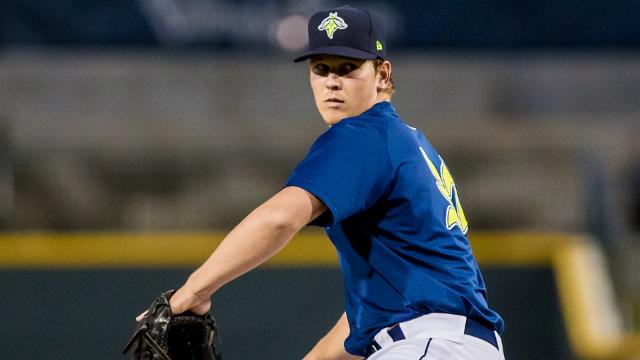
20. RHP Jordan Humphreys
Ht: 6’2″ Wt: 225 Level: Columbia & St. Lucie
B/T: R/R Age: 6/11/96 (20) Age Dif: -2.1 (St. Lucie)
Previous Rank: 33
Acquired: 18th Round Draft Pick in 2015
2016 Statistics: 10-1, 1.79 ERA, 13 G, 13 GS, 80.2 IP, 0.868 WHIP, 9.3 K/9
Profile: This season Humphreys was building upon an outstanding year in the Appalachian League that saw his name scattered across the Top 10 in most pitching categories, and he was the league leader in strikeouts. He was even better in the South Atlantic League forcing an earlier than expected promotion then came injury issues.
Humphreys initially struggled in the Florida State League, and the hope was this was a result of him adjusting to a new level. As it turns out, it might not have been. Humphreys has not pitched since June 30th, and there have been reports he has an elbow issue. The longer he remains out, the more reason there is for concern for a pitcher who was progressing quickly.
Batters were only hitting .168 against him in the Sally League, and Humphreys was striking out 10.3 batters per nine innings. Put another way, he was unhittable. His fastball was not only a swing and miss pitch, but it was also a pitch that induced a number of ground balls. He also found consistency with what is a very good curve ball.
C0nsidering the continued strides he showed, and his feel on the mound, his injury came at the wrong time . . . just like all injuries do. Hopefully, Humphreys is able to get back on the mound sooner rather than later and return to the form he showed.
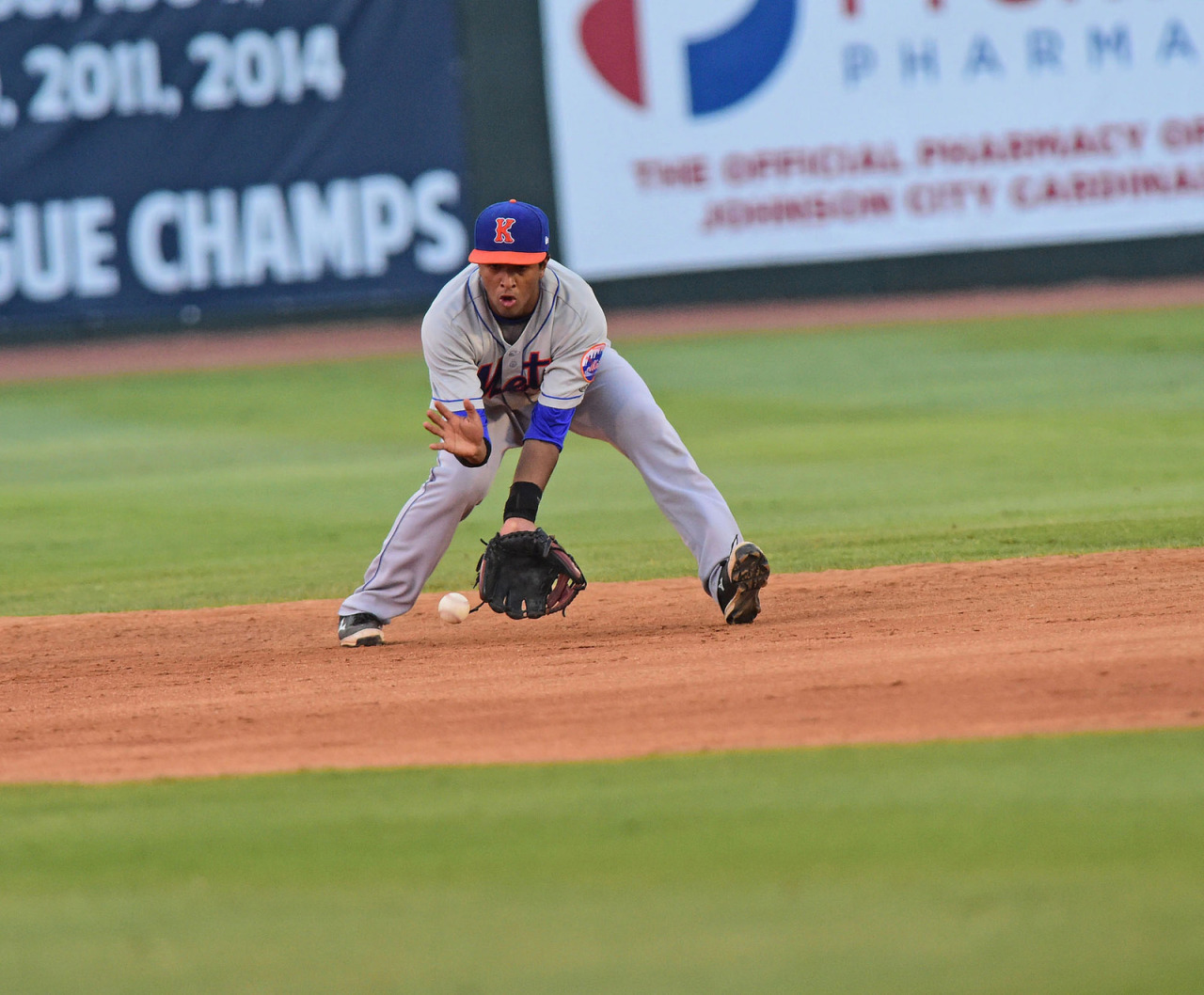
19. INF Luis Carpio
Ht: 6’0″ Wt: 165 B/T: R/R Level: Columbia
Age: 7/11/1997 (19) Age Dif: -2.5
Acquired: Signed by the New York Mets as a non-drafted free agent on July 11, 2013
Previous Rank: 16
2017 Stats: 97 G, 413 PA, 370 AB, 40 R, 88 H, 16 2B, 3 3B, HR, 27 RBI, 16 SB, 3 CS, .238/.305/.305
Profile: After undergoing surgery to repair a torn labrum in his right shoulder, Carpio was surprisingly able to make a cameo for the GCL Mets at the end of the 2016 season. It was less surprising Carpio debuted with Columbia this season.
One of the reasons why it isn’t surprising is the Mets have been very aggressive pushing Carpio through the Mets minor league system. At each stop, he has been quite young, but he has certainly held his own. One of the major reasons why is Carpio has always exhibited a strong work ethic. The other reason is he is flat out talented who knows what he is doing in the field at the plate.
Carpio is a line drive contact hitter who is willing to take a walk as evidenced by both is walk rate this year (8.7%) and his professional career (9.9%). Carpio can effectively use his speed to stretch singles into doubles and steal bases. With that said, one thing that is going to be an issue for him is he is a player teams can effectively shift against. Almost half of his batted balls are ground balls, and he pulls the ball almost half the time. This could go a long way towards explaining not just his poor offensive stats in Columbia, it could also explain his .269 BABIP since May 1st.
In the field, Carpio certainly has the range and IQ to play shortstop. However, what has always been at issue is his arm. While it was probably strong enough once to play short, his labrum surgery last year will likely force him to move to second base. If he does make such a move, he promises to be an outstanding defender at the position. Just for a point of reference, Carpio has a 4.67 range factor per nine at second this season. Last year, Joe Panik won the Gold Glove at second base with a 4.73 range factor.
Overall, not too much should be read into all of Carpio’s struggles this season. He may not yet bet at 100% after his surgery last season. He has also gone from 12 games in Brooklyn last year to playing in full season A ball while still being young for his level. With his work ethic, IQ, and with some more strength as the season progresses, we may very well see Carpio make the adjustments he needs to make to become the player many believe he can be.
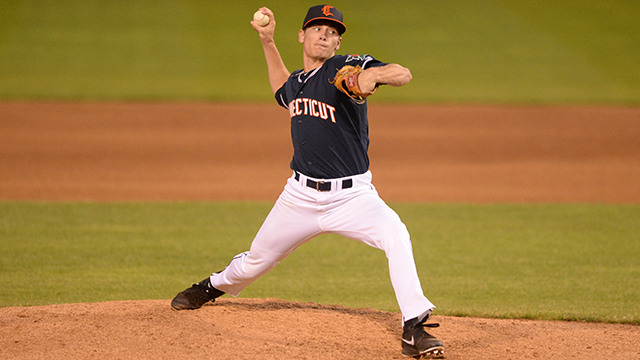
18. RHP Drew Smith
Ht: 6’2″ Wt: 190 lb. Mets Level: Binghamton
Age: 9/24/93 (23) Age Dif: -1.2
Acquired: Obtained from the Tampa Bay Rays for Lucas Duda (7/27/17)
Previous Rank: N/A
2017 Stats: 1-3, 1.53 ERA, 32 G, 7 SV, 47.0 IP, 0.894 WHIP, 7.7 K/9
Profile: It has been a bit of a whirlwind of a year for Smith. The Detroit Tigers 2015 third round draft pick was the player to be named later in a deal for fourth or fifth outfielder Mikie Mahtook. With the Rays, he made appearances at all three levels of the minors before settling at Double-A. As we know now, he’s now a member of the New York Mets. With most prospects. many wonder what the organization has in a player. With Smith being the first prospect obtained in a fire sale, there is certainly heightened interest.
Well, the one thing that really stands out with Smith is his velocity. He consistently lives in the high 90s, and as the season has progressed, he has gained a tick on his velocity with him throwing it more around 97-98 than 95-96. The one issue with his fastball is it is a straight fastball that does not generate much movement. Smith does abate this by having good control of the pitch. In this sense, control means not just throwing it for strikes, but throwing it where he wants to throw it.
In addition to his fastball, Smith has a promising curve ball. When Smith’s curve ball is going well, it is a good and effective pitch. At a minimum, it stands as a change of speed from his fastball. The issue with Smith is he is still working to get some consistency with the pitch. It should be noted this was a bigger issue for him with the Tigers organization. With him going to the Rays, he has thrown the pitch with a more consistency, and he has seen good results with the pitch.
With this stuff, there are really two things that jump off the page with you. The first is this guy just does not allow home runs. In fact, the only home run he has allowed in his professional career was to Mets first base prospect Peter Alonso. More than the homers, Smith doesn’t allow extra base hits. In 47.0 innings, Smith has faced 172 batters, and he has only allowed five extra base hits (four doubles, one homer).
The other thing you notice with Smith is he has a low strike out rate. Despite him nearing triple digit with his fastball and his developing his curve ball, Smith is only striking out eight batters per nine innings this year. In his four brief appearances above Single-A, Smith has yet to strike out a batter. He certainly has the stuff where you expect him to put up much bigger strikeout numbers, but it just isn’t happening for him right now.
In the end, the Mets have obtained a very interesting arm in Smith with a high ceiling as a future closer for the Mets. However, talk of him reaching such heights needs to be put on hold until he begins to learn to use his pitches better and get more strikeouts.
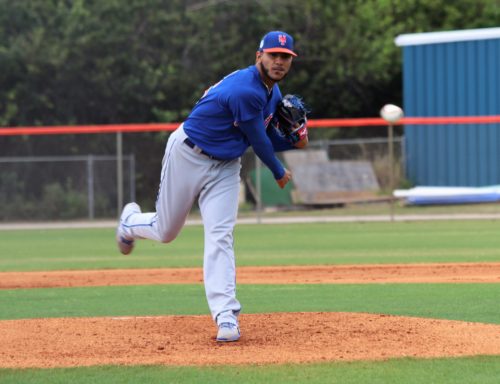
17. RHP Marcos Molina
Ht: 6’3″ Wt: 188 Level: St. Lucie & Binghamton
B/T: R/R Age: 3/8/95 (21) Age Dif: -2.4 (Binghamton)
Acquired: Signed as International Free Agent for $100,000 (January 2012)
Previous Rank: 13
2017 Stats: 2-8, 2.89 ERA, 12 G, 11 GS, 71.2 IP, 1.102 WHIP, 7.7 K/9
Profile: After missing a year with Tommy John surgery, Molina was a bit of a surprise addition to the Arizona Fall League roster last year. Naturally, the Mets limited his workload there, but in the limited appearances he made there, he pitched well. He pitched so well in fact the Mets added him to the 40 man roster to protect him from the Rule 5 Draft.
The one thing that stood out with Molina was he had better mechanics. While you can never pinpoint one reason for a pitcher needing Tommy John, Molina’s poor mechanics were cited as a reason. Basically speaking, he was putting all the stress on his arm because he took a short stride, and he used none of his lower half. In the Arizona Fall League, he was taking a longer stride, but still, he was not taking a long enough stride. He took those slightly improved but still lacking mechanics to St. Lucie this yaer.
He dominated to start the year in St. Lucie. We not only saw an return to his low to mid-90s velocity, we also saw him throw his change-up, which has always been a plus pitch for him. Another positive development was his slider was coming along. While still not a reliable pitch for him, Molina is certainly making strides. Because of how well he was both pitching and improving, he earned a promotion to Binghamton where things have not gone as well.
In six starts and one relief appearance for Binghamton, Molina is 0-5 with a 3.98 ERA, 1.326 WHIP, and an 8.0 K/9. Worse than the stats was the fact Molina wound up on the seven day disabled list. Fortunately, he was only on the disabled list for 12 days. With that said, Molina is struggling in Double-A.
There could be any number of factors. Molina is young for the level. He has yet to pitch a full season in the minors, and he is nearing his career high in innings pitched. That could be the case with the Mets already using him to piggyback starts. It could be a .351 BABIP against him. Whatever the reason, those concerns should be abated by the fact he has not had any arm issues this year, and he was excellent in his first start coming off the disabled list pitching six scoreless inning allowing just three hits.
16. RHP Stephen Nogosek
Ht: 6’2″ Wt: 205 lb Level: South Atlantic League (A)
B/T: R/R Age: 1/11/95 (22) Age Dif: 0.1
Acquired: One of three minor league relievers obtained from the Red Sox for Addison Reed (7/31/17)
Previous Rank: N/A
2017 Stats: 4-4, 3.00 ERA, 37 G, 19 SV, 54.0 IP, 1.130 WHIP, 10.7 K/9
Profile: Nogosek is a max effort reliever who uses a quick burst towards home plate while delivering a pitch. It’s one of those things where you would never teach anyone how to pitch this way, but it works for him. It works because it is startling to see a reliever almost jumping towards you, and it helps him somewhat hide his pitches. That’s important for a pitcher with a 3/4 delivery.
Nogosek’s tw0-seam fastball sits in the low to mid 90s, and it gets late sink. When batters do make contact, it is generally a ground ball as evidenced by his 2.10 ground ball/fly ball ratio in the Sally League last year. It should be noted, batters have had an easier time lifting the ball this year with that ratio now down to 0.69 this year. In addition to the two-seamer, Nogosek does have a four-seamer that can get as high as 96 MPH. The issue is the pitch is straight as a pin.
Nogosek combines his fastball with a slider/cutter and a change. Nogosek is able to throw that slider/cutter in the upper 80s, and he is able to generate a number of swings and misses with the pitch. At this point, the change-up does nothing more than present a change of pace. It’s not a swing and miss pitch, and it’s not a pitch that has enough movement to generate a number of outs.
Overall, Nogosek has a live arm, but he is still having some control issues as evidenced by his 5.8 walks per nine in the Carolina League and his 3.5 walks per nine in his minor league career.
Yesterday, Nogosek made his debut with the St. Lucie Mets pitching a scoreless inning and striking out a batter.
EDITOR’S NOTE: These rankings have been updated to reflect changes that have occurred in the Mets minor league system since the trade deadline.
PREVIOUS RANKINGS:


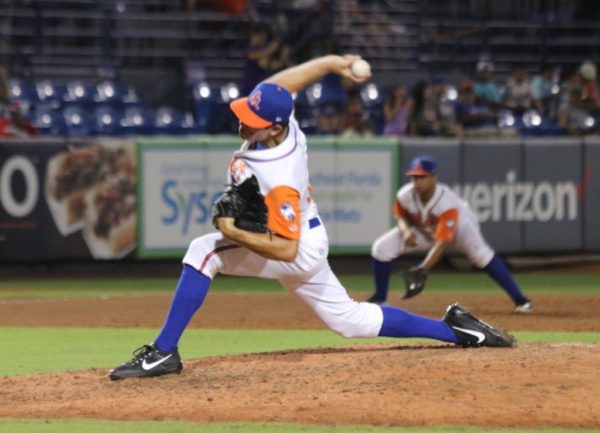
Does Anyone here know how to count?
Or proofread.
Apparently not.
Amateur Hour.
MMN Midseason Top 40: #20 – 16
40. RHP Jordan Humphreys
21. INF Luis Carpio
18. RHP Drew Smith
17. RHP Marcos Molina
16. RHP Stephen Nogosek
Fresh117s
abated…look it up